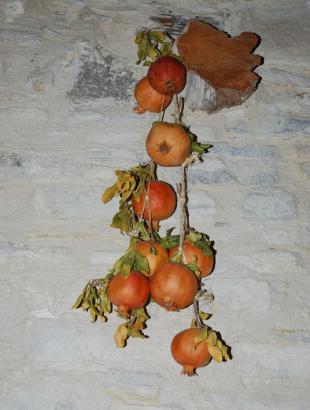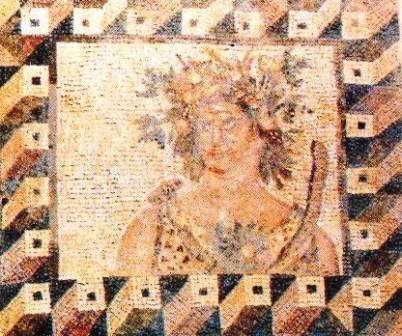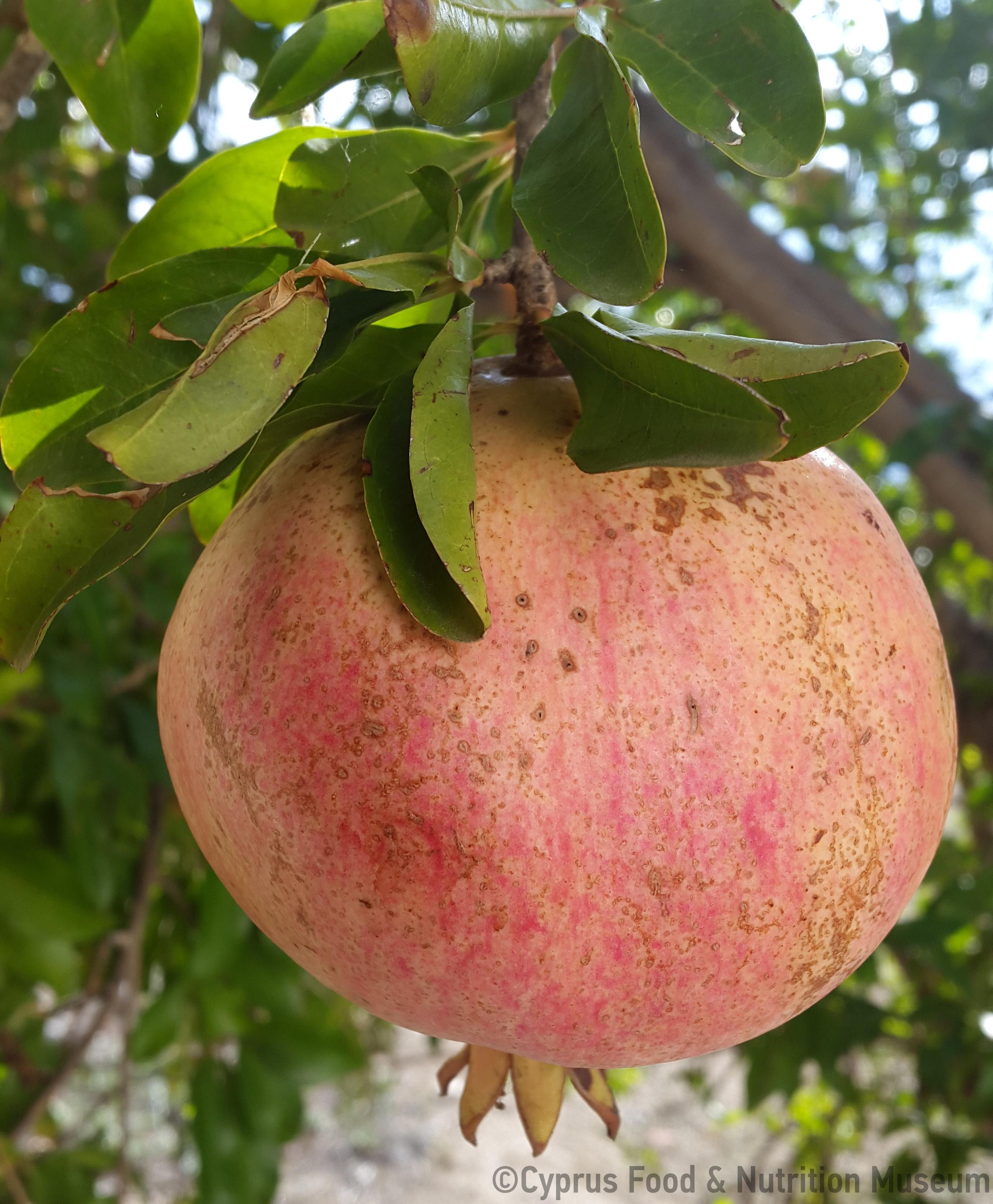In the summer months, when lemons were not available, women substituted lemon juice with sour pomegranate juice.
Name - Origin
Pomegranate is the edible fruit of the pomegranate tree which has the size of a large orange, roughly spherical shape, smooth skin, yellowish to red colour and is a multi-seeded fruit (Babiniotis 2005, entry ρόδι,το, 1550).
ETYM. < medieval roïdin < roïdion, sfrom ancient róa < réo, because of the abundant juice contained in the fruit or because of its laxative properties (Babiniotis 2005, entry ρόδι,το, 1550).
Ródi belongs to the family Punica Granatum L.
The pomegranate tree blossoms from April to May and its fruit ripen from August to November (Hadjikyriakou 2007).
Even the peels of the pomegranate, which they used to call rodófylla, were used for various purposes. After laying them to dry for a few days under the sun in the courtyard or on the roof of their house, they would sell them to street merchants. They would use them to dye yarn and traditional costumes (Ioannidis 2010, 69).
Xidkyá (a kind of black leather dye for leather boots) was made out of the peels after soaking them in vinegar for two or three days. The vinegar would turn black and it was used by shoemakers (Ioannidis 2010, 70).
The parts of the pomegranate containing the seeds are called papoúres, because of their similarity to the insect papaoúra, papás, or kokkonélis (Petrou-Poeitou 2013, entry Παπαούρα, 109).
Functional and symbolic role
Pomegranates were usually consumed fresh as an apetiser. In the summer months, when lemons were not available, women in the village of Agios Ambrosios, in the Kyrenia district, would substitute lemon juice with sour pomegranate juice (Hadjikyriakou 2007). Cypriots used the juice of sweet pomegranates to make a refreshing drink, while the bark and roots of the pomegranate were used to prepare a decoction, which was ideal in cases of dysentery and diarrhoea (Melifronidis 1980, 163). The decoction of pomegranate flowers was used to cure gingivitis and tonsillitis (Roussounidis 1988, 136).
Cypriots used pomegranate in almost all the important occasions of their lives. Pomegranate symbolised euphoria, which is why it was used after the wedding ceremony and in the sowing process. After a wedding ceremony, the new couple would throw a pomegranate on the floor at the entrance of their house, as they believed that breaking it open would bring them euphoria and many children (Roussounidis 1988, 118). Kollyva (a dish in commemoration of the dead) is prepared and distributed by women after burial of a deceased and the dish always contains pomegranate seeds, since their red colour symbolises the blood of the deceased (Roussounidis 1988, 127). In the Paphos district, women used to smear the lips of the newborn baby with pomegranate juice, honey and sugar in order for the baby to become sweet-tempered and good natured (Roussounidis 1988, 114-115). Before the start of breastfeeding, for symbolic and practical reasons, they used to give the infant pomegranate juice, grape juice or aniseed. They would squeeze the pomegranate to release its juice on the baby's lips or give the juice to the baby with a spoon. It was said that this would make the baby beautiful, happy, full of goodness or that the baby would turn ‘red’ like the pomegranate and full of health. In some villages, the pomegranate tree was watered with holy water so that the fruit would be holy. In general, they associated pomegranate with fruitfulness, fertility and abundance (Protopapa 2009, 267-268). In many villages, pomegranates were placed in the sowing basket to turn the wheat red and large (Roussounidis 1988, 108).
Additional information and bibliography
According to experts, the pomegranate tree (Punica Granatum L.) was one of the first trees cultivated in Cyprus, along with the olive and the fig tree. Many travellers mention Cypriot pomegranates. Among them, E. Pesaro (1563) mentions that there are sweet, sour and semi sweet pomegranates and that a large pomegranate fruit costs one quatrino (Hadjikyriakou 2007). Athanasios A. Sakellarios records that Cypriot pomegranates were the tastiest in the Mediterranean and that ships from Alexandria were loaded with pomegranates from Varosi (Varosi/ Varosha = area in the Famagusta district, now occupied by the Turks) (Sakellarios 1855, 247). Athenaeus XVI testifies that, in Cyprus, the pomegranate tree was planted by the goddess Aphrodite and was, therefore, a symbol of fertility and hope (Chatzikyriakou 2007). Pomegranate symbolised euphoria and the bearing of many offspring, which is why the bride, after returning from church, would throw a pomegranate on the doorstep of her house, the seeds of which would be scattered left and right (Ioannidis 2010, 70). Many varieties of pomegranates - kouforóvkia etc. - were grown for local consumption and for export to Egypt until the first decades of the 20th century. Trikomo (village in the Famagusta district, now occupied by the Turks) was famous for producing large quantities of good quality pomegranates, which were sold in the local market and also shipped by merchants to neighbouring countries.
Ioannides P. (2010) Τρίκωμο: Το Κεφαλοχώρι της Καρπασίας (Παράδοση - Ιστορία - Άνθρωποι), τ. Β΄ (1878 μ.Χ. - 2010 μ.Χ.), Nicosia.
Melifronides I. D. (1980) «Οι καρποί της ροδιάς», Λαογραφική Κύπρος 10,30, 162-163.
Babiniotis G. (2005) Λεξικό της Νέας Ελληνικής Γλώσσας. Με σχόλια για τη σωστή χρήση των λέξεων. Ερμηνευτικό, Ορθογραφικό, Ετυμολογικό, Συνωνύμων-Αντιθέτων, Κυρίων Ονομάτων, Επιστημονικών Όρων, Ακρωνυμίων, Centre for Lexicology, Athens, Greece.
Petrou-Poeitou E. (2013) Από πού κρατάει η σκούφια τους. Λέξεις και ιστορίες από τον κόσμο της γεύσης, Epiphaniou Publications, Nicosia.
Protopapa K. (2009), Τα έθιμα της γέννησης στην παραδοσιακή κοινωνία της Κύπρου, Publications of the Centre for Scientific Research, XLIX, Nicosia.
Roussounidis A. Ch. (1988) Δένδρα στην ελληνική λαογραφία με ειδική αναφορά στην Κύπρο, τ. Α΄, Publications of the Centre for Scientific Research, XII, Nicosia.
Sakellarios A. A. (1890) Τα Κυπριακά: Ήτοι Γεωγραφία, Ιστορία και Γλώσσα της Νήσου Κύπρου Από Των Αρχαιοτάτων Χρόνων Μέχρι Σήμερον, Τόμος Πρώτος: Γεωγραφία, Ιστορία, Δημόσιος Και Ιδιωτικός Βίος, Sakellariou press, Athens.
Hadjikyriakou N. G. (2011)Αρωματικά και αρτυματικά φυτά στην Κύπρο. Από την Αρχαιότητα μέχρι Σήμερα, Bank of Cyprus Cultural Foundation, Nicosia.
Dimitra Demetriou, Eleni Christou, Dimitra Zannetou, Stalo Lazarou, Argyro Xenophontos, Tonia Ioakim.



